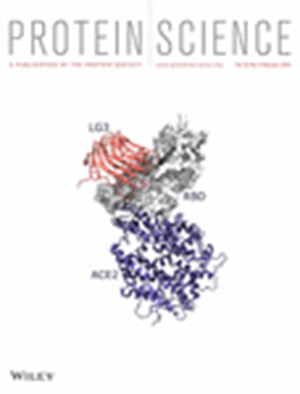针对脯氨酸生物合成酶 1-吡咯啉-5-羧酸 1(PYCR1)筛选基于知识的低分子量化合物库
IF 4.5
3区 生物学
Q1 BIOCHEMISTRY & MOLECULAR BIOLOGY
引用次数: 0
摘要
Δ1-吡咯啉-5-羧酸还原酶异构体 1(PYCR1)是脯氨酸生物合成的最后一种酶,催化 NAD(P)H 依赖性的Δ1-吡咯啉-5-羧酸还原为 L-脯氨酸。PYCR1基因的高表达可在许多癌症中观察到,并与患者的不良预后和肿瘤的侵袭性有关。研究表明,敲除PYCR1基因或抑制PYCR1酶可抑制癌细胞和癌症动物模型的肿瘤发生,从而推动了抑制剂的发现。我们利用酶活性测定法筛选了 71 种针对PYCR1 的低分子量化合物(平均分子量为 131 Da)。通过 X 射线晶体学和动力学测定验证了命中化合物,以确定亲和力参数。针对人Δ1-吡咯啉-5-羧酸还原酶同工酶 3 和脯氨酸脱氢酶 (PRODH) 对该化合物库进行了反筛选,以评估特异性/亲和性。测定了 12 种PYCR1 和 1 种 PRODH 抑制剂的晶体结构。三种化合物抑制PYCR1的竞争性抑制参数为100 μM或更低。其中,(S)-四氢-2H-吡喃-2-羧酸(70 μM)比目前最好的工具化合物 N-甲酰基-l-脯氨酸具有更高的亲和力,对PYCR1的特异性比人Δ1-吡咯啉-5-羧酸还原酶异构体 3 高 30 倍,而对 PRODH 的抑制作用可以忽略不计。结构-亲和力关系表明,该化合物杂原子的氢键是与PYCR1结合的重要因素。PYCR1 和 PRODH 与 1-hydroxyethane-1-sulfonate 复合物的结构表明,磺酸基团是羧酸锚的合适替代物。这一结果表明,探索羧酸同系物可能是发现新型PYCR1和PRODH抑制剂的一种有前途的策略。PYCR1与l-pipecolate和NADH复合物的结构支持了PYCR1在赖氨酸代谢中具有另一种功能的假设。本文章由计算机程序翻译,如有差异,请以英文原文为准。
Screening a knowledge‐based library of low molecular weight compounds against the proline biosynthetic enzyme 1‐pyrroline‐5‐carboxylate 1 (PYCR1)
Δ1 ‐pyrroline‐5‐carboxylate reductase isoform 1 (PYCR1) is the last enzyme of proline biosynthesis and catalyzes the NAD(P)H‐dependent reduction of Δ1 ‐pyrroline‐5‐carboxylate to L ‐proline. High PYCR1 gene expression is observed in many cancers and linked to poor patient outcomes and tumor aggressiveness. The knockdown of the PYCR1 gene or the inhibition of PYCR1 enzyme has been shown to inhibit tumorigenesis in cancer cells and animal models of cancer, motivating inhibitor discovery. We screened a library of 71 low molecular weight compounds (average MW of 131 Da) against PYCR1 using an enzyme activity assay. Hit compounds were validated with X‐ray crystallography and kinetic assays to determine affinity parameters. The library was counter‐screened against human Δ1 ‐pyrroline‐5‐carboxylate reductase isoform 3 and proline dehydrogenase (PRODH) to assess specificity/promiscuity. Twelve PYCR1 and one PRODH inhibitor crystal structures were determined. Three compounds inhibit PYCR1 with competitive inhibition parameter of 100 μM or lower. Among these, (S )‐tetrahydro‐2H‐pyran‐2‐carboxylic acid (70 μM) has higher affinity than the current best tool compound N ‐formyl‐l ‐proline, is 30 times more specific for PYCR1 over human Δ1 ‐pyrroline‐5‐carboxylate reductase isoform 3, and negligibly inhibits PRODH. Structure‐affinity relationships suggest that hydrogen bonding of the heteroatom of this compound is important for binding to PYCR1. The structures of PYCR1 and PRODH complexed with 1‐hydroxyethane‐1‐sulfonate demonstrate that the sulfonate group is a suitable replacement for the carboxylate anchor. This result suggests that the exploration of carboxylic acid isosteres may be a promising strategy for discovering new classes of PYCR1 and PRODH inhibitors. The structure of PYCR1 complexed with l ‐pipecolate and NADH supports the hypothesis that PYCR1 has an alternative function in lysine metabolism.
求助全文
通过发布文献求助,成功后即可免费获取论文全文。
去求助
来源期刊

Protein Science
生物-生化与分子生物学
CiteScore
12.40
自引率
1.20%
发文量
246
审稿时长
1 months
期刊介绍:
Protein Science, the flagship journal of The Protein Society, is a publication that focuses on advancing fundamental knowledge in the field of protein molecules. The journal welcomes original reports and review articles that contribute to our understanding of protein function, structure, folding, design, and evolution.
Additionally, Protein Science encourages papers that explore the applications of protein science in various areas such as therapeutics, protein-based biomaterials, bionanotechnology, synthetic biology, and bioelectronics.
The journal accepts manuscript submissions in any suitable format for review, with the requirement of converting the manuscript to journal-style format only upon acceptance for publication.
Protein Science is indexed and abstracted in numerous databases, including the Agricultural & Environmental Science Database (ProQuest), Biological Science Database (ProQuest), CAS: Chemical Abstracts Service (ACS), Embase (Elsevier), Health & Medical Collection (ProQuest), Health Research Premium Collection (ProQuest), Materials Science & Engineering Database (ProQuest), MEDLINE/PubMed (NLM), Natural Science Collection (ProQuest), and SciTech Premium Collection (ProQuest).
 求助内容:
求助内容: 应助结果提醒方式:
应助结果提醒方式:


